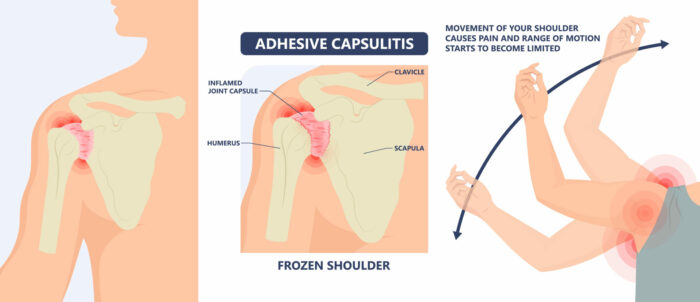
Frozen shoulder (adhesive capsulitis) is a painful and often misunderstood condition that can be highly debilitating. Symptoms may include shoulder, neck and arm pain. Invariably, there is a loss of mobility or range of shoulder motion. Simply put it hurts, it hurts almost all of the time and you cannot move the shoulder well.
What is a frozen shoulder/adhesive capsulitis?
To understand this problem, we need to know a little bit about the shoulder and how it works. The head of humerus rests in a tiny and relatively flat cup called the glenoid fossa. It’s at the end of your scapula, and it is smaller than a dime. The clavicle is also part of this joint. What holds the joint together are a couple of small ligaments, the joint capsule and the rotator cuff muscles.
Any injury to the joint (bone, ligament or muscle) within the region can cause pain to the shoulder. We respond to pain by splinting (we immobilize the shoulder). If we stop using the shoulder for any reason, within weeks, the shoulder capsule and ligaments can shrink and sometimes develop scarring. These adhesions can limit the mobility within the shoulder. When you try to move as you normally do, the joint capsule prevents the motion resulting in pain and inflammation.
Traditional western treatment can range from NSAIDs, cortisone, traditional PT, OT, manipulation under anesthesia or surgical release.
Alternative or complementary approaches should also be considered.
In this post we explore acupuncture treatment for adhesive capsulitis. Acupuncturists use a wide variety of approaches for this problem. Trigger point therapy, or the insertion of needles directly into painful points can be useful, but I prefer whole body approaches that treat not only symptoms but underlying causes.
During the examination, I want to see what movement is available in the shoulder, neck and arm. Are you able to reach for the ceiling with your arm? Behind your back? Can you reach cross the front of your body? Do your neck and forearm move freely? Any restrictions in mobility are noted. Than, I gently palpate your whole body and mark the tender areas. Problems in the left shoulder region may be related to an issue in the right hip.
I use a Five Element Acupuncture approach to treatment.
Both pain and the loss of mobility are a reflection of energetic blocks; places in the system where Qi and blood are not flowing freely. I use akabane testing and balancing to restore the balanced flow of Qi through the system.
The akabane test compares the energy of each of the twelve meridians. Using an ohm meter, I check the first point (jing well point) of each meridian on the left and right sides. If the reading is the same on both sides, there is no problem. If not, the discrepancy in electrical resistance shows a one sided block that I can remedy with acupuncture. Most often, rectifying a left/right block goes a long way to restoring movement and reducing pain in the shoulder as well as many other one sided musculoskeletal and neurologic problems.
As the corrections are made, and we retest the tender points. Once we have significantly reduced palpation pain, we retest ROM. It is remarkable how well this combination works for reducing pain and restoring ROM.
In FEA we are not just concerned with your physical symptoms. We are committed to the health of your mind and heart as well.
